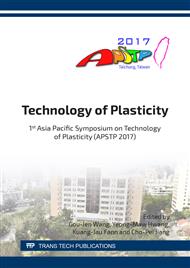p.102
p.108
p.114
p.120
p.126
p.132
p.141
p.149
p.155
Geometric Design of Rectangular Cross-Sectional Springs
Abstract:
In order to study the influence of the cross-sectional shape on the stiffness of a spring, a finite element analysis software DEFORM is used to simulate and analyze the torsion of rectangular cross-section bars. The material of the bar is TS1800 SAE9254 and the cross-section of aspect ratio (w / h) is 1.5. From literature it is known that when the rectangular section bar is twisted, the shear stress at the four corners is zero, so elliptical corners can decrease the volume and increase the stiffness with the same volume. Five levels for the long side of the elliptical corner are set as 1 to 5 mm, and 3 levels are set for the short side. Torsion of the rectangular section bars under 15 kinds of geometric designs are simulated to find the preferred cross-sectional shape design by evaluating the cross-sectional area, load, and the maximum shear stress. The objective of the design is obtaining a uniform stress distribution with a larger spring stiffness and lighter weight. The optimal cross section of the bars is established as the spring geometry, and the pre-loading processing of the spring is simulated. The required load and the maximum shear stress data are obtained. The effects of load, cross-sectional area and maximum shear stress on the springs performance are investigated.
Info:
Periodical:
Pages:
126-131
Citation:
Online since:
April 2018
Authors:
Price:
Сopyright:
© 2018 Trans Tech Publications Ltd. All Rights Reserved
Share:
Citation:


